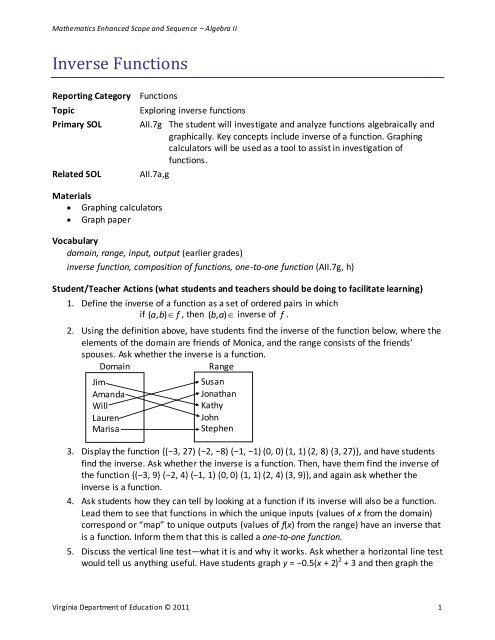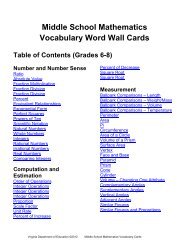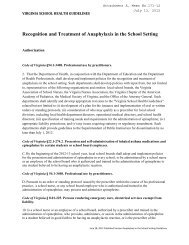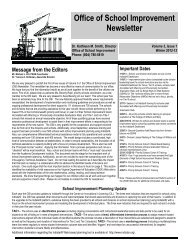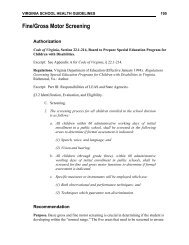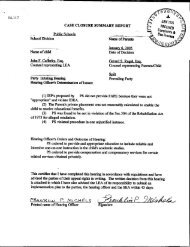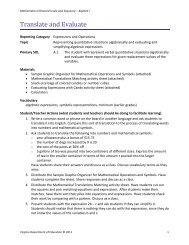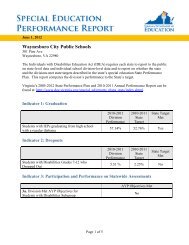Inverse Functions; Functions; AII.7g - Virginia Department of Education
Inverse Functions; Functions; AII.7g - Virginia Department of Education
Inverse Functions; Functions; AII.7g - Virginia Department of Education
You also want an ePaper? Increase the reach of your titles
YUMPU automatically turns print PDFs into web optimized ePapers that Google loves.
Mathematics Enhanced Scope and Sequence – Algebra II<br />
<strong>Inverse</strong> <strong>Functions</strong><br />
Reporting Category<br />
Topic<br />
Primary SOL<br />
Related SOL<br />
<strong>Functions</strong><br />
Exploring inverse functions<br />
<strong>AII.7g</strong> The student will investigate and analyze functions algebraically and<br />
graphically. Key concepts include inverse <strong>of</strong> a function. Graphing<br />
calculators will be used as a tool to assist in investigation <strong>of</strong><br />
functions.<br />
AII.7a,g<br />
Materials<br />
Graphing calculators<br />
Graph paper<br />
Vocabulary<br />
domain, range, input, output (earlier grades)<br />
inverse function, composition <strong>of</strong> functions, one-to-one function (<strong>AII.7g</strong>, h)<br />
Student/Teacher Actions (what students and teachers should be doing to facilitate learning)<br />
1. Define the inverse <strong>of</strong> a function as a set <strong>of</strong> ordered pairs in which<br />
if ( a , b)<br />
f , then ( b , a)<br />
inverse <strong>of</strong> f .<br />
2. Using the definition above, have students find the inverse <strong>of</strong> the function below, where the<br />
elements <strong>of</strong> the domain are friends <strong>of</strong> Monica, and the range consists <strong>of</strong> the friends’<br />
spouses. Ask whether the inverse is a function.<br />
Domain<br />
Range<br />
Jim<br />
Amanda<br />
Will<br />
Lauren<br />
Marisa<br />
Susan<br />
Jonathan<br />
Kathy<br />
John<br />
Stephen<br />
3. Display the function {(−3, 27) (−2, −8) (−1, −1) (0, 0) (1, 1) (2, 8) (3, 27)}, and have students<br />
find the inverse. Ask whether the inverse is a function. Then, have them find the inverse <strong>of</strong><br />
the function {(−3, 9) (−2, 4) (−1, 1) (0, 0) (1, 1) (2, 4) (3, 9)}, and again ask whether the<br />
inverse is a function.<br />
4. Ask students how they can tell by looking at a function if its inverse will also be a function.<br />
Lead them to see that functions in which the unique inputs (values <strong>of</strong> x from the domain)<br />
correspond or “map” to unique outputs (values <strong>of</strong> f(x) from the range) have an inverse that<br />
is a function. Inform them that this is called a one-to-one function.<br />
5. Discuss the vertical line test—what it is and why it works. Ask whether a horizontal line test<br />
would tell us anything useful. Have students graph y = −0.5(x + 2) 2 + 3 and then graph the<br />
<strong>Virginia</strong> <strong>Department</strong> <strong>of</strong> <strong>Education</strong> © 2011 1
Mathematics Enhanced Scope and Sequence – Algebra II<br />
horizontal line y = 2. Ask, “Where does the line intersect the parabola? Why does the<br />
horizontal line test work?”<br />
6. Explain that a function y = f(x) is a rule that tells us to do something with the input, x.<br />
Hence, f(x) = 2x tells us to multiply the input by 2. Emphasize that the inverse <strong>of</strong> f “undoes”<br />
whatever f does; therefore, f −1 (x) = 1 2 x, because 1 is the multiplicative inverse <strong>of</strong> 2. Show<br />
2<br />
students that to find the inverse <strong>of</strong> f ( x)<br />
3x<br />
1,<br />
you perform the inverse operations in<br />
1 x 1<br />
reverse order. That is, begin with your input, x, add 1, then divide by 3: f .<br />
3<br />
7. Demonstrate that for a function y = f(x) to have an inverse function, f must be one-to-one:<br />
that is, for every x in the domain, there is exactly one y in its range, and likewise, each y in<br />
the range corresponds to exactly one x in the domain. The correspondence from the range<br />
<strong>of</strong> f onto the domain <strong>of</strong> f is, therefore, also a function. It is this function that is the inverse<br />
<strong>of</strong> f.<br />
Domain <strong>of</strong> f<br />
Range <strong>of</strong> f<br />
0 Apply f(x)<br />
Apply f −1 (x)<br />
Input x<br />
4<br />
f(x) x<br />
f −1 [f(x)] = x<br />
Apply f −1 (x)<br />
Apply f(x)<br />
Input x f –1 (x) x<br />
f[f −1 (x)] = x<br />
8. Ask students to determine whether each pair <strong>of</strong> functions below is an inverse <strong>of</strong> one<br />
another.<br />
h(x) = x 3 and g(x) = 3 x<br />
h[g(x)] = x and g[h(x)] = x<br />
h( 3 x ) = x and g(x 3 ) = x<br />
3<br />
−<br />
1<br />
−<br />
7<br />
3 3 3<br />
x = x and x = x<br />
Students should find that they are indeed inverses. Tell them that because the pairs are<br />
1<br />
1<br />
inverses <strong>of</strong> one another, we say that g ( x)<br />
h ( x)<br />
and h(<br />
x)<br />
g ( x)<br />
.<br />
<strong>Virginia</strong> <strong>Department</strong> <strong>of</strong> <strong>Education</strong> © 2011 2
Mathematics Enhanced Scope and Sequence – Algebra II<br />
9. Have students enter Y 1 = x 3 and Y 2 = 3 x in their graphing calculators and set WINDOW so<br />
that −3 ≤ x ≤ 3 and −2 ≤ y ≤ 2. Ask what they observe about the graph. Then, have them<br />
enter Y 3 = x. Have them note the symmetry <strong>of</strong> the inverse functions with respect to y = x.<br />
Tell them to think about reflections. Using the TABLE function, point out that if (a,b) is on<br />
the graph <strong>of</strong> f, then (b,a) is on the graph <strong>of</strong> f −1 .<br />
10. Direct students to graph the points (−2,−1) (−1,0) (2,1) on a set <strong>of</strong> coordinate axes, connect<br />
the points with line segments, graph the inverse, and then graph y = x.<br />
11. Finding the inverse: Inform students that the graph <strong>of</strong> a one-to-one function, f, and its<br />
inverse are symmetric with respect to y = x. Therefore, we can identify f −1 by interchanging<br />
the roles <strong>of</strong> x and y: if f is defined by the equation y = f(x), then f −1 is defined by the<br />
equation x = f(y). The equation x = f(y) defines f −1 implicitly. Solving for y will produce the<br />
explicit form <strong>of</strong> f −1 as y = f −1 (x).<br />
12. Give students the function f(x) = 2x + 3, and ask whether f is one-to-one. (Yes, it is linear<br />
and increasing.)<br />
f(x) = 2x + 3<br />
y = 2x + 3<br />
x = 2y + 3<br />
The variables x and y have been interchanged in the original equation. This equation<br />
defines f −1 implicitly. Solving for y,<br />
2y + 3 = x<br />
2y = x − 3<br />
y = 1 (x − 3)<br />
2<br />
f −1 (x) = 1 (x − 3)<br />
2<br />
This is the explicit form.<br />
What is the domain <strong>of</strong> f ? What is the domain <strong>of</strong> f −1 ?<br />
What is the range <strong>of</strong> f ? What is the range <strong>of</strong> f −1 ?<br />
13. Have students graph Y 1 = f(x) = 2x + 3 and its inverse, Y 2 = f −1 (x) = 1 2 (x − 3), with Y 3 = x. Point<br />
out the symmetry <strong>of</strong> the graphs with respect to y = x.<br />
Assessment<br />
Questions<br />
3<br />
4<br />
o On graph paper, graph the functions f ( x)<br />
x 2 and g(<br />
x)<br />
x 2 . Are these<br />
4<br />
3<br />
functions inverses <strong>of</strong> one another? Why, or why not?<br />
o Graph f ( x)<br />
3x<br />
5.<br />
Now graph y x . Without manipulating the original function<br />
algebraically, graph f<br />
1 ( x ) . Use the line <strong>of</strong> reflection to determine points on the<br />
inverse function.<br />
Journal/Writing Prompts<br />
2<br />
o Describe, in detail, three methods for finding the inverse <strong>of</strong> f ( x)<br />
x 4 .<br />
3<br />
<strong>Virginia</strong> <strong>Department</strong> <strong>of</strong> <strong>Education</strong> © 2011 3
Mathematics Enhanced Scope and Sequence – Algebra II<br />
o<br />
o<br />
Explain what it means for a function to be “one-to-one,” and describe two methods<br />
for determining whether or not a function is one-to-one.<br />
Justify the identity function, y = x, being the line <strong>of</strong> reflection for a function and its<br />
inverse.<br />
Extensions and Connections (for all students)<br />
Have students find the inverse <strong>of</strong> y = f(x) = x 2 . Because f(x) is not one-to-one on its domain,<br />
restrict the domain to x ≥ 0.<br />
Have students graph y = 10 x and y = log x. Ask, “Are both functions one-to-one? Are they<br />
mirror images <strong>of</strong> one another? If so, with respect to which line? What can we conclude<br />
about the two functions?”<br />
Pose the following problem: “We have studied many functions, including absolute value,<br />
quadratic, square root, and cube root. Of those functions, identify which have inverses and<br />
which do not. Explain your reasoning.”<br />
Strategies for Differentiation<br />
Have students play a matching game to match inverse functions, both as graphs and as<br />
algebraic expressions. Use either cards or an interactive whiteboard.<br />
Use the following graphic organizer to remind students <strong>of</strong> the key concepts and processes<br />
for inverses.<br />
1<br />
1<br />
SWAP<br />
f <br />
f<br />
1<br />
Go over the meaning <strong>of</strong> the above, as follows:<br />
Elements <strong>of</strong> the inverse <strong>of</strong> a function<br />
are determined by<br />
( a,<br />
b)<br />
f ⇒ ( b,<br />
a)<br />
INV<strong>of</strong><br />
f<br />
The inverse <strong>of</strong> f is a function<br />
only if f is a one-to-one function.<br />
The graph <strong>of</strong> a function and its inverse<br />
are symmetric to the line y = x.<br />
To prove two functions are inverses <strong>of</strong> one<br />
another, show their composition is the<br />
identity function: f f<br />
1 ( x)<br />
x<br />
To find the inverse <strong>of</strong> a function, SWAP x and y, and solve for y.<br />
<strong>Virginia</strong> <strong>Department</strong> <strong>of</strong> <strong>Education</strong> © 2011 4


